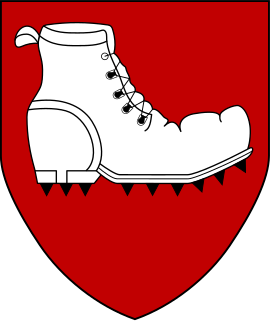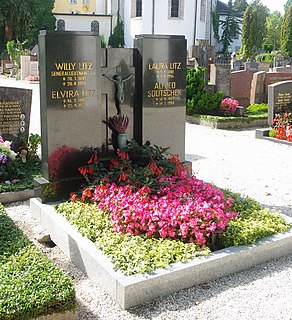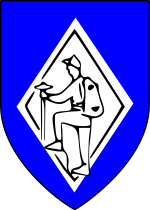
The 6th SS Mountain Division "Nord" was a German unit of the Waffen-SS during World War II, formed in February 1941 as SS Kampfgruppe Nord.
Mountain Corps Norway was a German army unit during World War II. It saw action in Norway and Finland.

The 334th Infantry Division was a German Army infantry division in World War II. Originally formed in November 1942, it surrendered to the Allies at the conclusion of the Tunisian Campaign in May 1943. The division was reconstituted on June 3, 1943 in France within the 1st Army, with the staff of the 80th Infantry Division as well as remnants of the old division and replacement units. It spent the remainder of the war serving on the Italian Front.
The 9th Mountain Division was the name given to two separate German military divisions by accident in 1945.

The 1st Mountain Division was an elite formation of the German Wehrmacht during World War II, and is remembered for its involvement in multiple large-scale war crimes. It was created on 9 April 1938 in Garmisch Partenkirchen from the Mountain Brigade which was itself formed on 1 June 1935. The division consisted mainly of Bavarians and some Austrians.
German Division Nr. 188 was raised in late 1939. It consisted of the 136th, 138th and 139th Mountain Replacement Regiments and the 112th Artillery Replacement Regiment, plus supporting units. It began the war on border guard duty in the mountainous region between Austria and Yugoslavia with the primary mission of training reservists and replacements for the regular mountain divisions. In the spring of 1941 it joined the invasion of Yugoslavia, with the three mountain regiments given responsibility of seizing control of Carniola and Carinthia on the Yugoslav side of the border, which they carried out quickly and effectively against little to no resistance.
The 4th Mountain Division was established in October 1940. It took part in the 1941 Balkans Campaign and then joined Army Group South in Operation Barbarossa after it was already underway. In 1942 it participated in the failed attempt to seize the Caucasus in Operation Edelweiss under Army Group A. Following the operation's failure, the division was pushed back into the Kuban bridgehead, then the Crimean Peninsula, the western Ukraine, Hungary, and Slovakia. The division surrendered to the Soviet forces near Czech city of Olomouc when the war ended in May 1945.

The 6th Mountain Division was established in June 1940, and was deployed to France for occupation duties. In December it was relocated to Poland, where it remained until the spring of 1941. It then took part in Operation Marita, the invasion of Greece during the Balkans Campaign. In September it was relocated to northern Finland, where it operated in Lapland. From July 1942 onward it was part of the 20th Mountain Army along the Arctic coast. It withdrew into Norway when the Germans evacuated Finland in late 1944, and surrendered to the British at the end of the war in 1945.

Gebirgsjäger are the light infantry part of the alpine or mountain troops (Gebirgstruppe) of Germany, Austria and Switzerland. The word Jäger is a characteristic term used for light infantry in German speaking countries.

The 7th SS Volunteer Mountain Division "Prinz Eugen", initially named the SS-Volunteer Division Prinz Eugen, was a German mountain infantry division of the Waffen-SS during World War II. It served only in occupied Yugoslavia. Formed in 1941 from both Germans and Volksdeutsche volunteers and conscripts from the Banat, Independent State of Croatia, Hungary and Romania, the division fought a bloody counter-insurgency campaign against communist-led Yugoslav Partisan resistance forces in the German-occupied territories of Serbia and Montenegro, as well as elsewhere in Yugoslavia.
The Alpenkorps was a provisional mountain formation of division size formed by the Imperial German Army during World War I. It was considered by the Allies to be one of the best in the German Army.

Michael Pössinger was a German bobsledder who competed in the early 1950s. He won a complete set of medals in the four-man event at the FIBT World Championships with a gold in 1951, a silver in 1954, and a bronze in 1953. Pössinger finished sixth in the four-man event at the 1956 Winter Olympics in Cortina d'Ampezzo.

Karl Hubert Lanz was a German general during the Second World War, in which he led units in the Eastern Front and in the Balkans. After the war, he was tried for war crimes and convicted in the Southeast Case, specifically for several atrocities committed by units under his command in the Balkans. Released in 1951, he joined the liberal Free Democratic Party and served as its adviser on military and security issues.

The 24th Waffen Mountain Division of the SS "Karstjäger" was a German mountain infantry division of the Waffen-SS, the armed wing of the German Nazi Party that served alongside, but was never formally part of, the Wehrmacht during World War II. Named Karstjäger, it was one of the 38 divisions fielded by the Waffen-SS. Formed on 18 July 1944 from the SS Volunteer Karstwehr Battalion, its nominal strength was never more than theoretical and the division was soon reduced to the Waffen Mountain (Karstjäger) Brigade of the SS. Throughout its existence as a battalion, division and brigade, it was primarily involved in fighting partisans in the Karst Plateau on the frontiers of Yugoslavia, Italy, and Austria; the mountainous terrain required specialised mountain troops and equipment.

The 7th Mountain Division was formed through the redesignation of 99th Light Infantry Division, which had fought on the southern sector of the Eastern Front until being withdrawn to Germany in October 1941. In 1942, it was sent to Finland and remained there until the Finnish withdrawal from the war. The Division retreated into Norway where it remained until the end of the War.

104th Jäger Division was an infantry division of the Germany Army in World War II. It was formed in April 1943, by the redesignation of the 704th Infantry Division, which was itself formed in April 1941. The division served in German occupied Yugoslavia in May 1941 where it took part in anti-partisan and security operations in the Independent State of Croatia. In April 1943, it was reorganized and redesignated the 104th Jäger Division and took part in the Battle of the Sutjeska in June 1943.
Following the Italian surrender, elements from the division took part in the murder of thousands of Italians from the 33 Infantry Division Acqui in September 1943, on the Greek island of Cefalonia in one of the largest-scale German atrocities to be committed by German Army troops instead of the Waffen SS.

The 33rd Infantry Division Acqui was a mountain infantry Division of the Italian Army during World War II. The only difference between line infantry divisions and mountain infantry divisions was that the latter's artillery was carried by pack mules instead of the standard horse-drawn carriages. Italy's real mountain warfare divisions were the six alpine divisions manned by the "Alpini" mountain troops. The Acqui Division was formed in August 1939 from the parts of 14th and 11th infantry brigades, and mobilized for war in October 1939. It is notable for having been massacred with remarkable cruelty after surrendering to the Germans on 21 September 1943. The main detachments of the Acqui division in the islands of Cephalonia and Corfu were officially dissolved 24 September 1943.

Harald von Hirschfeld was a war criminal and general in the Wehrmacht of Nazi Germany who commanded the 78. Volksgrenadier-Division during World War II. He was a recipient of the Knight's Cross of the Iron Cross with Oak Leaves.

Willibald Utz was a German general during World War II who commanded several divisions. He was a recipient of the Knight's Cross of the Iron Cross.

Helmuth Raithel was a German officer who held the rank of SS-Standartenführer (colonel) in the Waffen-SS during World War II. While still at school, Raithel was swept up in the excitement of the Munich Beer Hall Putsch of 9 November 1923 led by Adolf Hitler, and was subsequently awarded the coveted Blood Order, even though he was not a member of the Nazi Party. He joined the Reichswehr in 1926. After World War II broke out he fought in the invasion of Greece in summer 1941, then against the Soviet Red Army in northern Finland before transferring to the Waffen-SS in 1943.

















